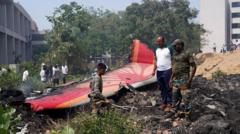Investigators have successfully recovered crucial data from the flight recorders of an Air India Boeing 787-8 Dreamliner that tragically crashed on June 12, just moments after departing from Ahmedabad airport for London. The Indian civil aviation ministry confirmed the development, marking a significant progress in the ongoing investigation into the disaster that claimed the lives of at least 270 individuals.
The Enhanced Airborne Flight Recorders (EAFRs), commonly known as black boxes, were retrieved from the crash site by investigators. They managed to recover both the cockpit voice recorder (CVR) and the flight data recorder (FDR) on June 13 and 16, respectively. The CVR captures pilot communications and cockpit sounds, while the FDR records essential flight parameters such as engine performance, flap settings, and other critical operational data. This information will be pivotal in piecing together the events leading to the crash, which occurred less than a minute after takeoff.
A team from India's Aircraft Accident Investigation Bureau (AAIB), along with representatives from the US National Transportation Safety Board (NTSB), accessed the recovered data on Wednesday. The aviation ministry stated that the analysis of both recorders is underway, with efforts focused on reconstructing the flight's last moments to uncover the root causes of the accident. Jennifer Homendy, chair of the NTSB, expressed hopes that the findings would be shared with the public soon for the sake of aviation safety and awareness.
The delayed access to the flight recorder data has raised eyebrows among aviation experts, some deeming it unusual for such investigations. The doomed Air India Flight 171, which was in the air for less than 40 seconds, crashed into a densely populated area of Ahmedabad, making it one of the most puzzling aviation disasters in recent Indian history. The flight, piloted by Captain Sumeet Sabharwal and co-pilot Clive Kundar, emitted a mayday call shortly before its final descent, emphasizing the importance of the ongoing investigation to prevent such tragedies in the future.
The Enhanced Airborne Flight Recorders (EAFRs), commonly known as black boxes, were retrieved from the crash site by investigators. They managed to recover both the cockpit voice recorder (CVR) and the flight data recorder (FDR) on June 13 and 16, respectively. The CVR captures pilot communications and cockpit sounds, while the FDR records essential flight parameters such as engine performance, flap settings, and other critical operational data. This information will be pivotal in piecing together the events leading to the crash, which occurred less than a minute after takeoff.
A team from India's Aircraft Accident Investigation Bureau (AAIB), along with representatives from the US National Transportation Safety Board (NTSB), accessed the recovered data on Wednesday. The aviation ministry stated that the analysis of both recorders is underway, with efforts focused on reconstructing the flight's last moments to uncover the root causes of the accident. Jennifer Homendy, chair of the NTSB, expressed hopes that the findings would be shared with the public soon for the sake of aviation safety and awareness.
The delayed access to the flight recorder data has raised eyebrows among aviation experts, some deeming it unusual for such investigations. The doomed Air India Flight 171, which was in the air for less than 40 seconds, crashed into a densely populated area of Ahmedabad, making it one of the most puzzling aviation disasters in recent Indian history. The flight, piloted by Captain Sumeet Sabharwal and co-pilot Clive Kundar, emitted a mayday call shortly before its final descent, emphasizing the importance of the ongoing investigation to prevent such tragedies in the future.



















